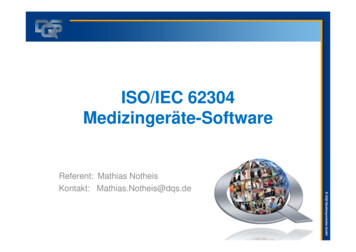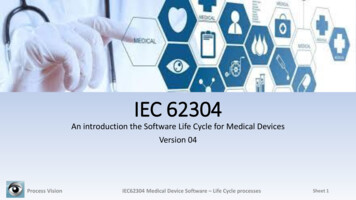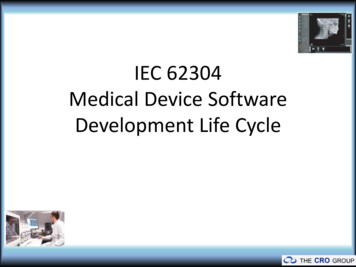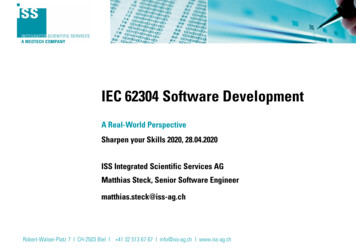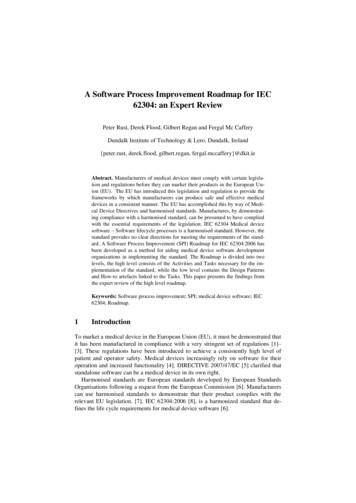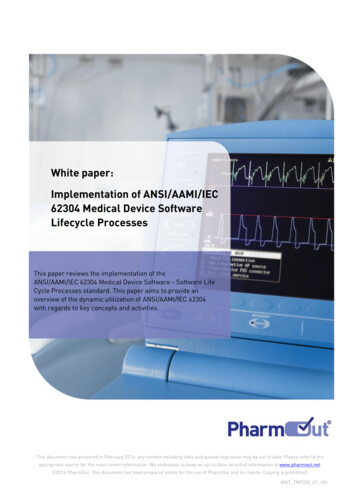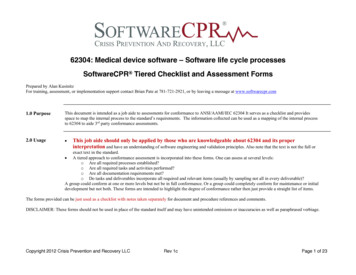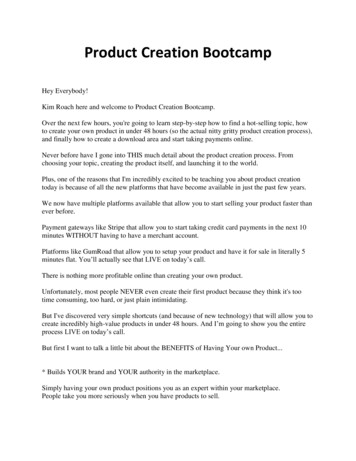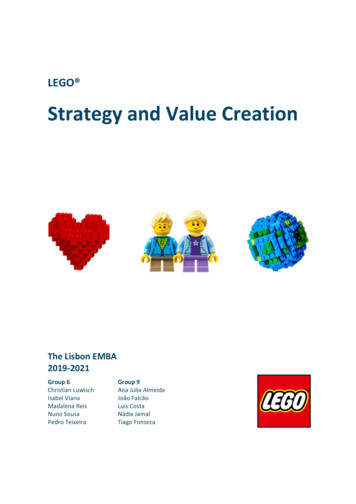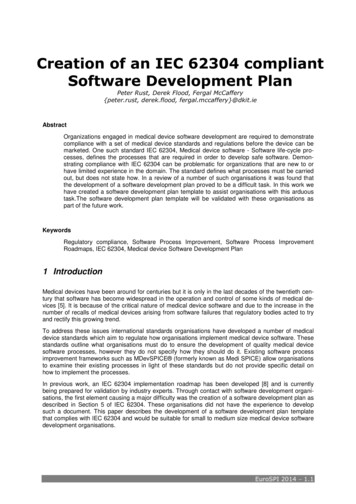
Transcription
Creation of an IEC 62304 compliantSoftware Development PlanPeter Rust, Derek Flood, Fergal McCaffery{peter.rust, derek.flood, fergal.mccaffery}@dkit.ieAbstractOrganizations engaged in medical device software development are required to demonstratecompliance with a set of medical device standards and regulations before the device can bemarketed. One such standard IEC 62304, Medical device software - Software life-cycle processes, defines the processes that are required in order to develop safe software. Demonstrating compliance with IEC 62304 can be problematic for organizations that are new to orhave limited experience in the domain. The standard defines what processes must be carriedout, but does not state how. In a review of a number of such organisations it was found thatthe development of a software development plan proved to be a difficult task. In this work wehave created a software development plan template to assist organisations with this arduoustask.The software development plan template will be validated with these organisations aspart of the future work.KeywordsRegulatory compliance, Software Process Improvement, Software Process ImprovementRoadmaps, IEC 62304, Medical device Software Development Plan1 IntroductionMedical devices have been around for centuries but it is only in the last decades of the twentieth century that software has become widespread in the operation and control of some kinds of medical devices [5]. It is because of the critical nature of medical device software and due to the increase in thenumber of recalls of medical devices arising from software failures that regulatory bodies acted to tryand rectify this growing trend.To address these issues international standards organisations have developed a number of medicaldevice standards which aim to regulate how organisations implement medical device software. Thesestandards outline what organisations must do to ensure the development of quality medical devicesoftware processes, however they do not specify how they should do it. Existing software processimprovement frameworks such as MDevSPICE (formerly known as Medi SPICE) allow organisationsto examine their existing processes in light of these standards but do not provide specific detail onhow to implement the processes.In previous work, an IEC 62304 implementation roadmap has been developed [8] and is currentlybeing prepared for validation by industry experts. Through contact with software development organisations, the first element causing a major difficulty was the creation of a software development plan asdescribed in Section 5 of IEC 62304. These organisations did not have the experience to developsuch a document. This paper describes the development of a software development plan templatethat complies with IEC 62304 and would be suitable for small to medium size medical device softwaredevelopment organisations.EuroSPI 2014 1.1
Session I: Session title will be inserted by editors2 Related Work2.1Medical Device Software QualityWallace and Kuhn [5] describe how in the years, 1983 to 1991 6% of the recalls registered with theFDA were due to software failures and how for the years 1994 to 1996 this had risen to 10%.ANSI/AAMI/SW68 Medical device software - Software life cycle processes [6] was adopted in 2001and its stated purpose was to reduce the time required for regulatory review of medical device software by reducing the material that must be reviewed while providing a development process that willconsistently produce high quality, safe medical device software. IEC 62304 was introduced in 2006and is based on ANSI/AAMI/SW68 with a number of significant additional requirements. IEC 62304has been adopted by the ANSI as an US national standard (replacing ANSI/AAMI/SW 68). Howeverthe number of medical device recalls registered with the FDA that related to software issues has continued to increase. Alemzadeh et al.[7] describe how 33.3% of Class I (presenting a high risk of severeinjury or death to patients) recalls between 2006 and 2011 were software related. The standards stateclearly what is required by medical device software development organisations, but do not tell theorganisation how to implement these requirements.The development of safe medical device software requires quality management, risk management,and good software engineering [1]. The purpose of IEC 62304 Medical device software — Softwarelife-cycle processes [2] is to define the lifecycle requirements for medical device software developmentand to establish a common framework for medical device software life cycle processes. IEC 62304also requires a medical device software development organisation to have a quality management system in place that demonstrates the ability to provide medical device software that consistently meetscustomer requirements and applicable regulatory requirements. ISO 13485 Medical devices - Qualitymanagement systems - Requirements for regulatory purposes [3] is one such standard. IEC 62304also requires that a risk management process complying with ISO 14971 [4] be applied to the softwaredevelopment life cycle processes.2.2RoadmappingThe roadmapping process is established and proven in the technology domain and continues to beadopted in many other fields of endeavour. Phaal [9] lists over 2000 public domain roadmaps organized by topic including chemistry, construction, defence, energy, transport and many more. A numberof large companies use roadmapping to develop their strategic planning going forward. NASA embraced roadmapping in 2005 [10] arising out of a number of cost overruns in their development budgets.Within the SPI domain, the number of published roadmaps is limited. McFeeley et al., [11] have developed a high level process improvement roadmap and describe how their roadmap is intended to provide an organization with a guide to forming and carrying out an SPI program.Höss et al., [12] launched a pilot project to acquire skills in implementing IEC 62304 in a hospitalbased environment (in-house manufacture). They concluded that the pilot project carried out at theirfacility clearly demonstrated that the interpretation and implementation of IEC 62304 is not feasiblewithout appropriately qualified staff. They recognized that it could be carried out by a small team withlimited resources although the initial effort is significant and a learning curve must be overcome.It can be seen that applying the roadmapping process to IEC 62304 and generating a roadmap thatwill aid medical device software development organizations in the implementation of IEC 62304 is anecessary and justified step.Flood et al. [13][14] have already applied the roadmapping process to ISO 14971 and IEC 62366 andthese roadmaps have been validated with industry experts. A roadmap has also been developed fortraceability in the medical device domain leaving the development of an IEC 62304 roadmap as the1.2 EuroSPI 2014
Session I: Session title will be inserted by editorslast piece of the puzzle.IEC 62304 is not a standalone standard and the manufacturer of a medical device is responsible forensuring compliance with the other relevant standards. Irrespective of the lifecycle model chosen, theprocesses defined in the standard must form part of the model and be implemented during the development of the medical device software. One method organizations have of doing this is through mapping the standard to their particular life cycle model. The IEC 62304 implementation roadmap will remove this step in the software development process as the requirements of IEC 62304 are alreadymapped to the defined processes, identified as Activities and any gaps that exist in the organizationsprocesses will be detected.2.3General Software Development PlanningThe Institute of Electrical and Electronics Engineers (IEEE) produced Standard 1058:1998 Standardfor Software Project Management Plans [15] to specify the format and content of software projectmanagement plans. When ISO/IEC/IEEE 16326:2009 Systems and software engineering — Life cycleprocesses — Project management, which harmonised ISO/IEC TR 16326:1999 and IEEE Standard1058:1998, was introduced, software development plans were identified as separate entities. Section5.9 Additional plans (Clause 9 of the PMP) states “For projects dealing with software intensive systems or software products, these additional requirements are usually documented in two additionalplans created at a lower level of abstraction than the PMP. These additional plans are the systemengineering management plan (SEMP) and the software development plan (SDP).” These standardsstate what must be contained within a plan but do not give examples of such a plan. McConnell, in hisSoftware Project Survival Guide [16], details a software project development plan template, based onIEEE 1058 – 1998. One of the main features of this plan is that it separates the managerial processes,the technical processes and the work packages, schedule and budget.3 A roadmap for IEC 62304The definition of a Roadmap for the purposes of applying the roadmapping process to this and theother standards in the domain is “A series of Activities, comprised of Tasks that will guide an organization through the use of specific “How To’s” towards compliance with regulatory standards”.Figure 1 Metaphor for RoadmapA roadmap for the implementation of IEC 62304 has been developed and the metaphor detailed infigure 1 was developed to aid organisations in the visualisation of the activities that were required andEuroSPI 2014 1.3
Session I: Session title will be inserted by editorsalso to give an indication of the timeline associated with the implementation of the processes requiredby IEC 62304.It can be seen in this figure that a number of the required processes are on-going right throughout thedevelopment of the project and in some cases, right to the end of the life of the product. These processes have been defined to ensure the safety of all users of the medical device, including operators,patients and healthcare professionals.The roadmap outlines the stages at which each process should be introduced into the organisationand these processes may be performed multiple times through the life of the project. As can be seenorganisations must first start with the implementation of a quality management system and a riskmanagement process compliant with ISO 14971. The organisation must then establish the classification of the device and ensure that for all artefacts produced as part of the project are controlled anduniquely identified, including all modifications and revisions.At this point the organisation would be in a position to begin the development of the medical devicesoftware. The first stage in this process is to plan the software development process including all ofthe necessary stages from requirements analysis through to releasing the process.4 Research MethodThe aim of this work is to assist organisations with the implementation of IEC 62304. To meet this aimwe began by examining the current software development practices of two organisations new to themedical device domain in light of the IEC 62304 standard. This work revealed that the most prominentissue was a lack of a software development plan.To assist these organisations in the creation of the software development plan the following researchmethod was undertaken.1. Examine current software development practices within the medical device organisations: The first stage in the implementation of the roadmap was to examine the organisationsexisting processes and determine which elements were most urgently required. This examination revealed that the most prominent issue faced by these organisations was the lack of asoftware development plan.2. Examine general Software Development Plans and compare them with the requirementsof IEC 62304: The requirements of IEC 62304 were mapped into the template and a comparison made between the contents of the template and the requirements of IEC 62304. Detailsfrom the annexes were also included so that the rationale behind the requirements were understood and could be easily referenced by the authors of the actual medical device softwaredevelopment plan.3. Develop Generic Software Development Plan template which satisfies the requirementsof IEC 62304: The outcome of the comparison process was a generic medical device software development plan that encompassed all elements of the original project plan, elementsderived from best practice, the requirements of IEC 62304 and the rationale from the annexesof the standard.4. Examined the organisations existing planning documentation in light of the template:Once the template was developed the organisations existing planning documentation was examined to determine if additional elements were required to complete the software development plan template developed in Stage 3.5 Results5.1Examination of Current Software Development PracticesAs described previously, contact was made with two software development organisations who were1.4 EuroSPI 2014
Session I: Session title will be inserted by editorsplanning to enter the medical device software development domain. Organisation A is a small softwaredevelopment house with approximately fifteen employees. They are specialists in the mobile application market. Organisation B is an organisation who as part of a multinational company has experienceof manufacturing medical devices and some limited experience in developing medical device softwarebut who have identified the need to set up a separate division to take responsibility for the development of medical device software that will form part of any medical device that they manufacture. Bothorganisations have already begun their journey on the road to IEC 62304 compliance by investing in aquality management system complying with ISO 13485 [3] (QMS) and a risk management systemcomplying with ISO 14971 [4] (RMS). Their questio
IEC 62304 is not a standalone standard and the manufacturer of a medical device is responsible for ensuring compliance with the other relevant standards. Irrespective of the lifecycle model chosen, the processes defined in the standard must form part of the model and be implemented during the devel-opment of the medical device software. One method organizations have of doing this is through .
